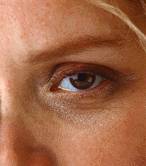- Navigating Your Midlife Crisis: Embracing New Possibilities
- City Raccoons Showing Signs of Domestication
- Mapping the Exposome: Science Broadens Focus to Environmental Disease Triggers
- One Week Less on Social Media Linked to Better Mental Health
- Your Brain Changes in Stages as You Age, Study Finds
- Some Suicide Victims Show No Typical Warning Signs, Study Finds
- ByHeart Formula Faces Lawsuits After Babies Sickened With Botulism
- Switch to Vegan Diet Could Cut Your Greenhouse Gas Emissions in Half
- Regular Bedtime Does Wonders for Blood Pressure
- Dining Alone Could Mean Worse Nutrition for Seniors
Why Skin Wrinkles More Around the Eyes


Facial wrinkles — such as so-called “laugh lines” or “crow’s feet” — are the bane of many aging adults. Now, new research on cadavers may offer some insight into why some skin creases are more pronounced than others.
Differences in oil-secreting glands just below the skin may help explain why forehead wrinkles are shallower than wrinkles around the outer eye, according to a research team led by Yuichi Tamatsu, of Kagoshima University Graduate School of Medical and Dental Sciences in Japan.
Sebaceous glands are “microscopic glands that secrete sebum, an oily or waxy material, which lubricates the skin and protects it from water damage,” said Dr. Nitin Chauhan, a facial plastic and reconstructive surgeon and otolaryngologist at the University of Toronto.
Chauhan, who was not part of the new research, said that based on the study findings, it appears that wrinkles in the face tend to be deeper where sebaceous glands are less concentrated — namely, the outer corners of the eyes.
Chauhan also said evidence of a gland-wrinkle skin connection appeared to be confined to the top half of the face.
The study results were published in the July 1 online edition of Clinical Anatomy.
To explore factors related to facial wrinkling, the researchers examined wrinkle depth, gland density, and dermal skin density in forehead and eye region skin samples from 58 Japanese cadavers. The ages represented ranged from 20s to 90s.
The research team concluded that the more sebaceous glands present under the forehead-region skin, the shallower the wrinkles.
A lack of sebaceous glands around the outer corners of the eyes could explain why wrinkles in that area tend to be deeper than forehead creases, the researchers said.
The investigators also observed that greater gland density was associated with a thicker dermal skin layer — the second layer of skin, which lies below the sweat glands and hair follicles contained in the outer epidermis.
While the researchers said they hoped their work might ultimately pave the way for anti-wrinkle treatment development, they acknowledged that many factors in addition to gland density probably play a role in wrinkle-depth variations.
Also, the study authors cautioned that because their effort focused exclusively on Japanese skin, “it remains unknown whether lighter or darker types of skin would show similar tendencies.”
Ashani Weeraratna, an assistant professor in the molecular and cellular oncogenesis program at the Wistar Institute in Philadelphia, agreed with that reservation.
While “extremely interesting,” the study focuses only on tissue from embalmed cadavers “from one race of people,” she said.
“There is a wide range of wrinkling seen among races, where certain races generally have less wrinkling than others, so it is hard to imagine that [gland] differences can fully account for that,” Weeraratna said.
Chauhan, meanwhile, suggested that while the study findings do not break any new ground in the science behind skin health, they were generally “in keeping with expectations based on facial aging patterns.”
But for the time-being, she said, those genuinely interested in reducing wrinkle-risk should focus their energies on improving lifestyle habits.
“Hydration is key,” she said. Drinking plenty of fluids “is critical to skin metabolism, toxin processing, nutrient delivery and maintaining skin [elasticity].”
Chauhan also said that sun protection, a healthy diet, regular exercise and good sleep are all “important components in ensuring optimal skin metabolism, which manifests in attractive skin.”
More information
The American Academy of Dermatology has more about healthy skin care habits.
Source: HealthDay
Copyright © 2025 HealthDay. All rights reserved.










